Chapter 18: The Early Twentieth Century & Fascism
Russian Revolutions
The last Tsar of Russia was Nikolai II (1868–1918). At the start of his reign in 1894, at the death of his father Alexander III, Nikolai was among the most powerful monarchs in Europe. Russia may have been technologically and socially backwards compared to the rest of Europe, but it commanded an enormous empire and boasted a powerful military. Alone among the monarchs of the great powers, the Tsars had successfully resisted most of the forces of modernity that had fundamentally changed the political structure of the rest of Europe. Nikolai ruled in much the same manner as had his father, grandfather, and great grandfather before him, holding nearly complete authority over day-to-day politics and the Russian Church.
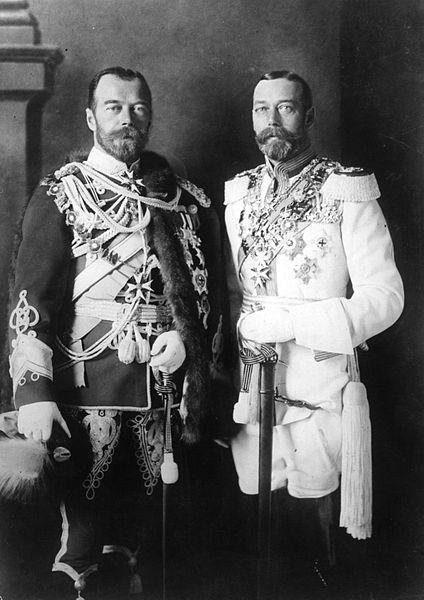
It was, however, during his reign that modernity finally caught up with Russia. The Russian state was able to control the press and punish dissent into the first years of the twentieth century, but then events outside of its immediate control undermined its ability to exercise complete control over Russian society. The immediate cause of the downfall of Nikolai’s royal line, and the entire traditional order of Russian society, was war: The Russo-Japanese War of 1904–1905 and, 10 years later, World War I.
Japan shocked the world when it handily defeated Russia in the Russo-Japanese War. To many Russians, the Tsar was to blame for the defeat in both allowing Russia to remain so far behind the rest of the industrialized world economically, and because he himself had proved an indecisive leader during the war. Following the Russian defeat, 100,000 workers tried to present a petition to the Tsar asking for better wages, better prices on food, and the end of official censorship. Troops fired on the crowds, which were unarmed, sparking a nationwide wave of strikes. For months, the nation was rocked by open rebellions in navy bases and cities, and radical terrorist groups managed to seize certain neighborhoods of the major metropolises of St. Petersburg and Moscow. Nikolai finally agreed to allow a representative assembly, the Duma, to meet, and after months of fighting the army managed to regain control.
The aftermath of this (semi-)revolution saw the Tsar still in power and various newly constituted political parties elected to the Duma. Very soon, however, it was clear that the Duma was not going to serve as a counter-balance to Tsarist power. The Tsar retained control of foreign policy and military affairs. In addition, the parties in the Duma had no experience of actually governing, and quickly fell to infighting and petty squabbles, leaving most actual decision making where it always had been: with the Tsar himself and his circle of aristocratic advisors. Still, some things did change thanks to the revolution: unions were legalized and the Tsar was not able to completely dismiss the Duma. Most importantly, the state could no longer censor the press effectively. As a result, there was an explosion of anger as various forms of anti-governmental press spread across the country.
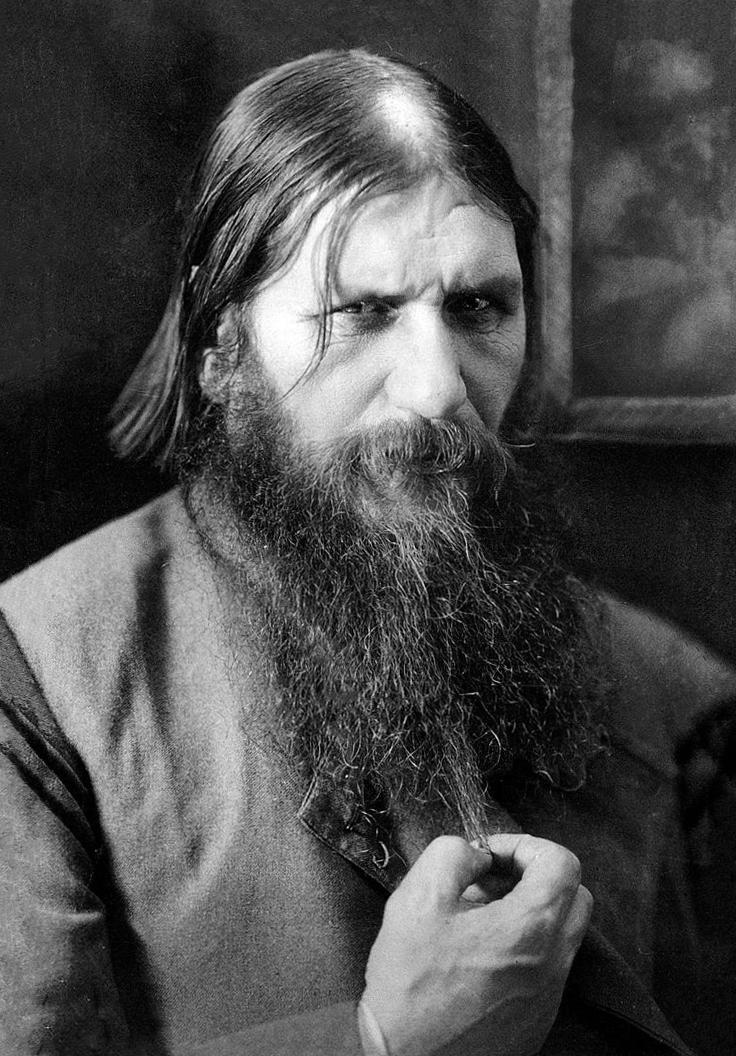
One of Nikolai’s many concerns was that his only male heir, Prince Alexei, was a hemophiliac (i.e. his blood did not clot properly when he was injured, meaning any minor scrape or cut was potentially lethal). Nikolai’s wife, Tsarina Alexandra, called upon the services of a wandering, illiterate monk and faith healer named Grigori Rasputin. Rasputin, definitely one of the most peculiar characters in modern history, was somehow able (perhaps through a kind of hypnotism) to stop Alexei’s bleeding, and the Tsarina thus believed that he had been sent by God to protect the royal family. Rasputin moved in with the Tsar’s family and quickly became a powerful influence, despite being the son of Siberian peasants, and despite the fact that part of his philosophy was that one was closest to God after engaging in sexual orgies and other forms of debauchery.
When World War I began in 1914, the already fragile political balance within the Russian state teetered on the verge of collapse. In the autumn of 1915, as Russian fortunes in the war started to worsen, Nikolai departed for the front to personally command the Russian army. In 1916 a desperate conspiracy of Russian nobles, convinced that Rasputin was the cause of Russia’s problems, managed to assassinate him. By then, however, the German armies were steadily pressing towards Russian territory, and tens of thousands of Russian troops were deserting to return to their home villages. As the social and political situation began to approach outright anarchy, one group of Russian communists steeped in the tradition of radical terrorism stood ready to take action: the Bolsheviks.
The form of radical politics that had taken root in Russia in the late nineteenth century revolved around apocalyptic revolutionary socialism. Mikhail Bakunin was the exemplary figure in this regard: Bakunin believed that the only way to create a perfect socialist future was to utterly destroy the existing political and social order, after which “natural” human tendencies of peace and altruism would manifest and create a better society for all. By the late nineteenth century, this homegrown Russian version of socialist theory was joined with Marxism, as various Russian radical thinkers tried to determine how a Marxist revolution might occur in a society like theirs that was still largely feudal.
The problem with Marxist theory faced by Russian Marxists was that, according to Marx, a revolution could only happen in an advanced industrial society. The proletariat would recognize that it had “nothing to lose but its chains” and overthrow the bourgeois order. In Russia, however, industrialization was limited to some of the major cities of western Russia, and most of the population were still poor peasants in small villages. This did not look like a promising setting for a revolution of the industrial working class.
The key figure who saw a way out of this theoretical impasse was Vladimir Lenin. Lenin was an ardent revolutionary and a major political thinker. He created the concept of the “vanguard party”: a dedicated group of revolutionaries who would lead both workers and peasants in a massive uprising. Left to their own devices, he argued, workers alone would always settle for slight improvements in their lives and working conditions (he called this “trade union consciousness”) rather than recognizing the need for a full-scale revolutionary change. The vanguard party, however, could both instruct workers and lead them in the creation of a new society. Led by the party, not only could a communist revolution succeed in a backwards state like Russia, but it could “skip” a stage of (the Marxist version of) history, jumping directly from feudalism to socialism and bypassing industrial capitalism.
In Lenin’s mind, the obvious choice of a vanguard party was his own Russian communist party, the Bolsheviks. By 1917, the Bolsheviks were a highly organized militant group of revolutionaries with contacts in the army, navy, and working classes of the major cities. When political chaos descended on the country as the possibility of full-scale defeat to Germany loomed, the Bolsheviks had their chance to seize power.
On International Women’s Day in February of 1917 (using the Eastern Orthodox calendar still in use at the time—it was March in the west), women workers in St. Petersburg demonstrated against the Tsar’s government to protest the price of food, which had skyrocketed due to the war. Within days the demands had grown to ending the war entirely and even calling for the ouster of the Tsar himself, and a general strike was called. Comparable demonstrations broke out in the other major cities in short order. The key moment, as had happened in revolutions since 1789, was when the army refused to put down the uprisings and instead joined them. The Duma demanded that the Tsar step aside and hand over control of the military. By early March, just a few weeks after it had begun, the Tsar abdicated, realizing that he had lost the support of almost the entire population.
In the aftermath of this event, power was split. The Duma appointed a provisional government than enacted important legal reforms but did not have the power to relieve the Russian army at the front or to provide food to the hungry protesters. Likewise, the Duma itself represented the interests and beliefs of the educated middle classes, still only a tiny portion of the Russian population as a whole. The members of the Duma hoped to create a democratic republic like those of France, Britain, or the United States, but they had no road map to bring it about. Likewise, the Duma had no way to enforce the new laws it passed, nor could they compel Russian peasants to fight on against the Germans. Most critically, the members of the Duma refused to sue for peace with Germany, believing that Russia still had to honor its commitment to the war despite the carnage being inflicted on Russian soldiers at the front.
Soon, in the industrial centers and in many of the army and naval bases, councils of workers and soldiers (called soviets) sprang up and declared that they had the real right to political power. There was a standoff between the provisional government, which had no police force to enforce its will, and the soviets, which could control their own areas but did not have the ability to bring the majority of the population (who wanted, in Lenin’s words, “peace, land, and bread”) over to their side. Many fled the cities for the countryside, peasants seized land from landowners, and soldiers deserted in droves; by 1917 fully 75% of the soldiers sent to the front against Germany deserted.
Thus, as of the late summer of 1917, there was a power vacuum created by the war and by the incompetence of the Duma. No group had power over the country as a whole, and so the Bolsheviks had their opportunity. In October the Bolsheviks took control of the most powerful soviet, that of Petrograd (former St. Petersburg). Next, the Bolsheviks seized control of the Duma, expelled the members of other political parties, and then stated their intention to pursue the goals that no other major party had been willing to: unconditional peace with Germany and land to the peasants with no compensation for landowners. In early 1918, after consolidating their control in Petrograd and Moscow, the Bolsheviks signed the Treaty of Brest-Litovsk with Germany, granting Germany huge territorial concessions in return for peace (Germany would lose those new territories when it lost the war itself later that year).
Almost immediately, a counter-revolution erupted and civil war broke out. The Bolsheviks proved effective at rallying troops to their cause and leading those troops in war. Their “Red Army” engaged the “White” counter-revolutionaries all over western Russia and the Ukraine. For their part, the Whites were an ungainly coalition of former Tsarists, the liberals who had been alienated by the Bolshevik takeover of the Duma, members of ethnic minorities who wanted political independence, an anarchist peasant army in the Ukraine, and troops sent by foreign powers (including the United States), terrified of the prospect of a communist revolution in a nation as large and potentially powerful as Russia. Despite the fact that very few Russians were active supporters of communist ideology, the Red Army still proved both coherent and effective under Bolshevik leadership.
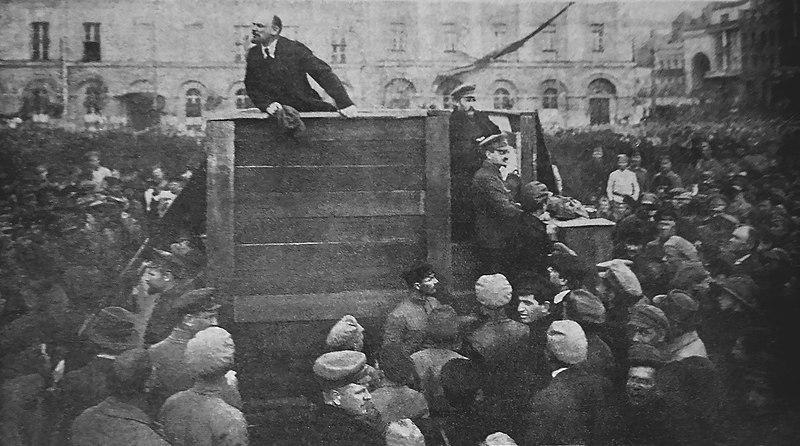
The ensuing war was brutal, ultimately killing close to ten million people (most were civilians who were massacred or starved), and lasting for four years. In the end, however, the Bolsheviks prevailed in Russia itself, Ukraine, and Central Asia. Some Eastern European countries, including Poland, Finland, and the Baltic states, did gain their independence thanks to the war, but everywhere else in the former Russian Empire the Bolsheviks succeeded in creating a new communist empire in its place: the Union of Soviet Socialist Republics (USSR).
Early Twentieth-Century Cultural Change
The Bolshevik Revolution and the subsequent creation of the USSR represents perhaps the most striking political event of its time, but it occurred during a period of profound political, cultural, and intellectual instability across Europe and much of the world. The first few decades of the twentieth century revolved around World War I in many ways, but even before the war began Western society was riven with cultural and political conflict. It was an incredibly tumultuous time, one in which “Western Civilization” struggled to define itself in the face of scientific progress and social change that seemed to be speeding forward ever faster.
Part of this phenomenon was the fact that the old order of monarchy and nobility was finally, definitively destroyed, a casualty of World War I. Never again would kings and emperors and noblemen share power over European countries. At the same time, the great political project of the nineteenth century, republican democracy, seemed profoundly disappointing to many Europeans, who had watched it degenerate into partisan squabbles that were helpless to prevent the Great War and its terrible aftermath. In that aftermath there was a terrific flowering of cultural and intellectual production even as the continent struggled to recover economically. It is tempting to see these years, especially the interwar period between 1918 and 1939, as nothing more than the staging ground for World War II, but a more accurate picture reveals them as being much more than just a prequel.
Modernism
Modernism in the arts refers to a specific period starting around 1900 and coming into its own in the 1920s. It expressed a set of common attitudes and assumptions that centered on a rejection of established authority. It was a movement of skepticism directed toward the post-Victorian middle class, an overhaul of the entire legacy of comfort, security, paranoia, rigidity, and hierarchy. It rejected the premise of melodrama, namely clear moral messages in art and literature that were meant to edify and instruct. Socially, it was a reaction against the complacency of the bourgeoisie, of their willingness to start wars over empire and notions of nationalism.
Modernist art and literature sometimes openly attacked the moral values of mainstream society, but sometimes experimented with form itself and simply ignored moral issues. This was the era of l’art pour l’art (“art for art’s sake”), of creation disinterred from social or intellectual duty. Artists broke with the idea that art should “represent” something noble and beautiful, and instead many indulged in wild experiments and deliberately created disturbing pieces meant to provoke their audience. Sometimes, modernists were distinctly “modern” in glorifying industrialism and technology, while other times they were modern in that they were experimenting with entirely novel approaches to creation.
One of the quintessential modernist movements was Futurism. Starting in Italy before World War I, Futurism was a movement of poets, playwrights, and painters who celebrated speed, technology, violence, and chaos. Their stated goal was to destroy the remnants of past art and replace it with the art of the future, an art that reflected the modern, industrial world. Futurism sought something new and better than what the Victorian bourgeoisie had come up with: something heroic.
The Futurists were just one branch of modernism in the In visual arts. Other schools existed across Europe, including Vorticism in England, Expressionism in Austria, and Cubism in France. Pablo Picasso (1881–1973), the major cubist painter and sculptor, was one of the quintessential modernist painters in that he portrayed objects, people, even the works of past masters, but he did so from several different perspectives at once. The English Vorticists, meanwhile, attempted to capture the impression of motion in static paintings, not least by depicting literal explosions in their art.
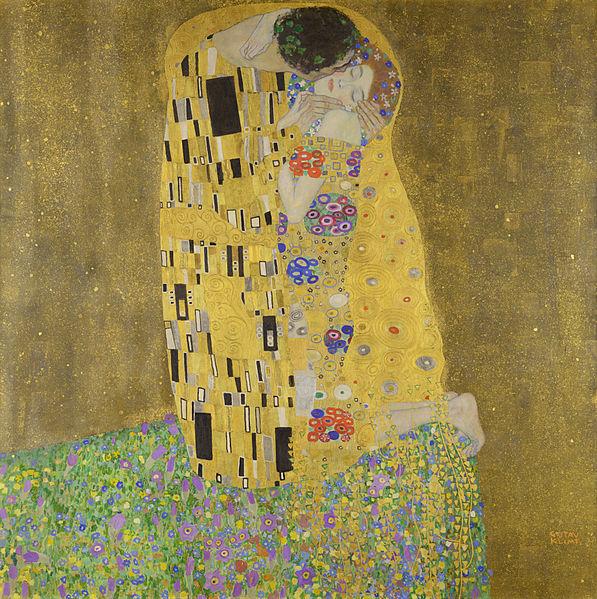
Among the creators of the most striking, sometimes beautiful, but other times grotesque images associated with modernism were the Austrian expressionists. The major point of expressionism was to put the artist’s inner life on display through abstract, often disturbing images. The governing concept was not to depict things “as they are,” but instead to reflect the disturbing realities of the artist’s mind and spirit. The greatest Austrian expressionist was Gustav Klimt (1862–1918), who created beautiful but haunting and often highly eroticized portraits, the most famous of which became one of the quintessential dorm room decorations of collegiate America: The Kiss.
In 1901, the University of Vienna commissioned Klimt to create paintings to celebrate the three great branches of traditional academic scholarship: philosophy, medicine, and law. In each case, Klimt created frightening images in which the nominal subject matter was somehow present, but was overshadowed by the grotesque depiction of either how it was being carried out or how it failed to adequately address its subject. Philosophy, for instance, depicts a column of naked, wretched figures clinging to one another over a starry abyss, with a sinister, translucent face visible in the backdrop. The paintings were all beautiful and skillfully rendered, but also dark and disturbing (the originals were destroyed by the Nazis during their occupation of Austria—Modernism was considered “degenerate art” by the Nazi party).
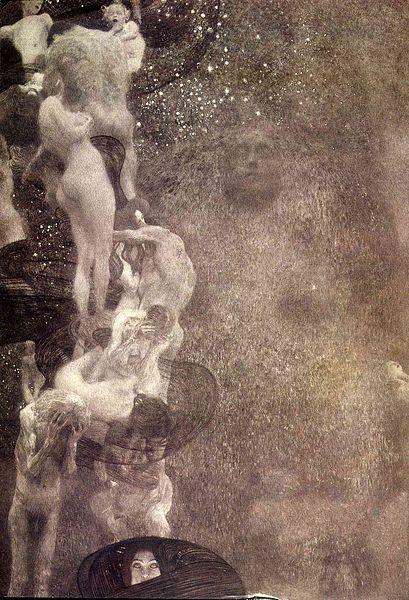
Modernism was not confined to literature and the visual arts, however. Some composers and musicians in the first decades of the twentieth century sought to shatter musical traditions, defying the expectations of their listeners by altering the very scales, notes, and tempos that western audiences were used to hearing. Some of the resulting pieces eventually became classics in their own right, while others tended to become part of the history of music more so than music very many people actually listened to.
One of the most noteworthy modernist composers was Igor Stravinsky (1882 – 1971). A Russian composer, Stravinsky’s was best known for his Rite of Spring. The Rite of Spring was a ballet depicting the fertility rites of the ancient Scythians, the nomadic people native to southern Russia in the ancient past. Staged by classical ballet dancers, the Rite of Spring completely scandalized its early audiences; at its first performance in Paris, members of the audience hissed at the dancers, and pelted the orchestra with debris, while the press described it as pornographic and barbaric. The dancers lurched about on stage, sometimes in an overtly sexual manner, and the music changed its tempo and abandoned its central theme. Within a few years, however (and following a change in its wild choreography), the Rite became part of ballet’s canon of great pieces.
In contrast, the Austrian composer Arnold Schoenberg (1874–1951) invented a form of orchestral music that remains more of an important influence to avant-garde musicians and composers than something actively listened to by mainstream audiences. Schoenberg’s major innovations consisted of experiments with atonality—music without a central, binding key—and a newly invented 12-tone scale of his own creation. Schoenberg was among the first to defy the entire tradition of western music in his experiments. Ever since the Renaissance, western musicians had worked in basically the same set of scales. As a result, listeners were “trained” from birth to expect certain sounds and certain rhythms in music. Schoenberg deliberately subverted those expectations, inserting dissonance and unexpected notes in many of his works.
Similar in some ways to the innovations in the visual arts and music, modernist literature created out a new approach to poetry and prose. Authors like Virginia Woolf, Marcel Proust, Franz Kafka, and James Joyce (whose places of origins spanned from Dublin to Prague) created a new form of literature in which the nominal plot of a story was less important than the protagonist’s inner life and experience of his or her surroundings and interactions. Joyce’s (incredible difficult to read) novel Ulysses described a single unremarkable day in the life of a man in Dublin, Ireland, focusing on the vast range of thoughts, emotions, and reactions that passed through the man’s consciousness rather than on the events of the day itself. Proust and Woolf also wrote works focused on the inner life rather than the outside event, and Woolf was also a seminal feminist writer. Kafka’s work brilliantly, and tragically, satirized the experience of being lost in the modern world, hemmed in by impersonal bureaucracies and disconnected from other people. His most famous story, Metamorphosis, describes the experience of a young man who awakens one day to discover that he has become a gigantic insect, but whose immediate concern is that he will be unable to make it in to his job.
Ultimately, artistic modernism in the arts, music, and literature questioned the (post-)Victorian obsession with traditional morality, hierarchy, and control. The inner life was not straightforward – it was a complicated mess of conflicting values, urges, and drives, and traditional morality was often a smokescreen over a system of repression and violence. Certain modernist artists attacked the system, while others exposed its vacuity, its emptiness or shallowness, against the darker, more complex reality they thought lay underneath.
Gender Roles
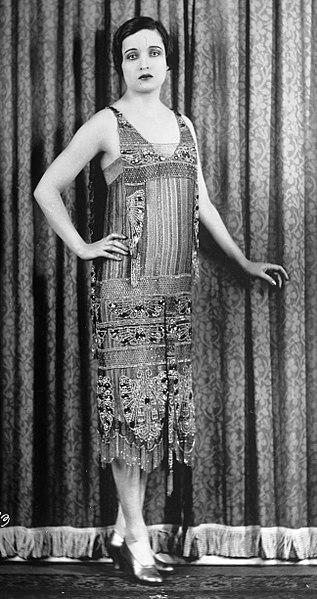
Those destinies, however, were slowly changing. As noted in the discussion of World War I in the previous chapter, gender roles had been transformed both economically and culturally during (and because of) the war. Some of those changes were durable. The range of jobs available to women was certainly larger than it had been before the war. Women continued to wear more comfortable and practical clothing after the war than before it, the restrictive ankle-length dress replaced by the looser, calf-length dress or skirt. Some women continued to cut their hair short, and of course women’s suffrage was finally realized (albeit with various restrictions) in most European countries and the United States over the course of the 1920s.
No sooner had the war ended, however, that men generally did everything in their power to reverse many of the changes to gender roles it had caused. Through a combination of legal restrictions and quasi-legal practices, women were forced from traditional male jobs, prevented from enrolling in universities and medical schools, and paid significantly less than men for the same work. Fascist parties (described in a following chapter) were explicitly devoted to enforcing traditional gender roles, and when some countries were overtaken by fascist rule women were often forced out of the workplace. Everywhere, most men (and many women) continued to insist that women were inherently biologically inferior to men and that it was the “natural” role of men to serve as head of the household and head of the nation-state in equal measure.
The exemplar of both the greater freedom enjoyed by women and male resentment of that freedom was the “New Woman.” A stock figure in the media of the time, the New Woman was independent, working at her own job full time and living by herself, and able to enjoy a social life that included drinking, dancing, and even the possibility of casual sex. The famous “flappers” of the 1920s, young women in the latest fashion who danced to cutting-edge American jazz and wore scandalously short, knee-length dresses, were the ultimate expression of the New Woman. While the image of the New Woman was greatly exaggerated, both in advertising and by male misogynists, there was at least a kernel of truth to the archetype. Far more women were independent by the 1920s than in the past, fashions really had changed, and thanks to halting advances in contraception, casual sexual relationships were easier to have without fear of pregnancy. It would take at least another half-century, however, for laws against sexual discrimination to come into being in most countries, and of course the struggle for cultural equality remains unfulfilled to this day.
The Great Depression
Modernism in the arts and modernist theory came of age before, during, and after World War I; some of the most interesting writing and art of the modernist movement occurred during the 1920s. The political order of Europe (Russia, as usual, was an exception) and the United States during the 1920s was beset by struggle and conflict, but while the economies of the west struggled to recover from World War I, there was at least some economic growth. That growth came crashing to a halt in 1929 with the advent of the Great Depression.
The Great Depression has the dubious distinction of being the worst economic disaster in the modern era. It constituted an almost total failure of governments, businesses, and banks to anticipate or prevent economic disaster or to effectively deal with it. The Depression explains in large part the appeal of extremist politics like Nazism, in that the average person was profoundly frightened by what had happened to their world; instead of progress resulting in better standards of living, all of a sudden the hard-won gains of the recent past were completely ruined.
The background to the Depression was the financial mess left by World War I. The victorious alliance of Britain and France imposed massive reparations on Germany: 132 billion gold marks. In addition, the former members of the Triple Entente themselves owed enormous sums to the United States for the loans they had received during the war, amounting to approximately $10 billion. Over the course of the 1920s, as the German economy struggled to recover (at one point the value of German currency collapsed completely in the process), the US government oversaw enormous loans to Germany. In the end, a “triangle” of debt and repayment locked together the economies of the United States and Europe: US loans underwrote German reparation payments to Britain and France, with Britain and France then trying to pay off their debts to the US. None of the debts were anywhere near settled by the end of the 1920s, not least because more loans were still flooding into the market.
The Depression started in the United States with a massive stock market crash on October 24, 1929. The ill-conceived cycle of debt described above had worked well enough for most of the 1920s while the American economy was stable and American banks were willing to underwrite new loans. When the stock market crashed, however, American banks demanded repayment of the European loans, from Germany and its former enemies alike. The capital to repay those loans simply did not exist. Businesses shut down, governments defaulted on the American loans, and unemployment soared. In one year, Germany’s industrial output dropped by almost 50% and millions were out of work. In turn, inspired by liberal economic theories, governments embraced policies of austerity, cutting back the already limited social programs that existed, balancing state budgets, and slashing spending. The result was that even less capital was available in the private sector. In the United States and Western Europe, the Depression would drag on for a decade (1929–1939), at which point World War II overshadowed economic hardship as the great crisis of the century.
Summing Up
What do Modernist art, shifts in gender, and the Great Depression have in common besides chronological coincidence? They were all, in different ways, symptoms of disruption and (often) a profound sense of unease that pervaded Western culture after World War I. European civilization was powerful and self-confident before the war, master of over 80% of the globe, and at the forefront of science and technology. That civilization emerged from four years of bloodshed economically shattered, politically disunited, and in many ways skeptical of the possibility of further progress. It was in this uncertain context that the most destructive political philosophy in modern history emerged: fascism, and its even more horrific offshoot, Nazism.
Disappointment
In many ways, World War I was what truly ended the nineteenth century. It undermined the faith in progress that had grown, despite all of its setbacks, throughout the nineteenth century among many, perhaps most, Europeans. The major political movements of the nineteenth century seemed to have succeeded: everywhere in Europe nations replaced empires (nationalism). Europe controlled more of the world in 1920 than it ever had or ever would again (imperialism). In the aftermath of the war, almost every government in Europe, even Germany, was a republican democracy based on the rule of law (liberalism). Even socialists had cause to celebrate: there was a nominally Marxist state in Russia and socialist parties were powerful and militant all across Europe. The old order of monarchs and nobles was rendered all but obsolete, with noble titles holding on as nothing more than archaic holdovers from the past in nearly every country. In addition, of course, technology continued to advance apace.
Despite the success of all of those movements, however, with all of the hopes and aspirations of their supporters over the last century, Europe had degenerated into a horrendous and costly war. The war had not purified and invigorated the great powers; they were all left reeling, weakened, and at a loss for how to prevent a future war. Science had advanced, but its most noteworthy accomplishment was the production of more effective weapons. The global empires remained, but the seeds of their dissolution were already present.
The results were bitterness and reprisals. The Treaty of Versailles that ended the war imposed harsh penalties on Germany, returning Alsace and Lorraine to France and imposing a massive indemnity on the defeated country. The Treaty also required Germany to accept the “war guilt clause,” in which it assumed full responsibility for the war having started in the first place. Simultaneously, the Austrian Empire collapsed, with Hungary, Czechoslovakia, and the new Balkan nation of Yugoslavia all becoming independent countries and Austria a short-lived republic. Almost no one would have believed that another “Great War” would occur in twenty years.
In other words, World War I did not resolve any of the problems or international tensions that had started it. Instead, it made them worse because it proved how powerful and devastating modern weapons were, and it also demonstrated that no single power was likely to be able to assert its dominance. France and Britain went out of their way in blaming Germany for the conflict, while in Germany itself, those on the right believed in the conspiracy theory in which communists and Jews had conspired to sabotage the German war effort. This was later called the “Stab in the Back” myth. Thus, many Germans felt they had been wronged twice: they had not “really” lost the war, yet they were forced to pay outrageous indemnities to the “victors.”
It was in this context of anger and disappointment that fascism and its racially obsessed offshoot Nazism arose. World War I provided the trauma, the bloodshed, and the skepticism toward liberalism and socialism that underwrote the rise of fascism. Fascism was a modern conservatism, a conservatism that clung to its mania for order and hierarchy, but which did not seek a return to the days of feudalism and monarchy. It was a populist movement, a movement of the people by the people, but instead of petty democratic bickering, it glorified the (imagined) nation, a nation united by a movement and an ethos.
Fascism
Fascism centered on the glorification of the state, the rejection of liberal individualism, and an incredible emphasis on hierarchy and authority. Fascist movements sprung up right as the war ended. The term fascism was invented by the Italian Fascist Party itself, based on the term fascii: a bundle of sticks with an axe embedded in the middle. Symbolically, the sticks are weak individually but strong as a group, and the axe represented the power over life and death. In ancient Rome, the bodyguards of the Roman consuls carried fascii as a badge of authority over war, peace, law, and death, and that symbolism appealed to the Italian Fascists.
By the early 1920s, there were fascist movements in many European countries, all of them agitating for some kind of right-wing revolution against democracy and socialism. One place of particular note in the early history of fascism was France. There, a right-wing monarchist group called Actione Française had existed since the Dreyfus Affair, but it transformed itself into a French fascist group despite still clinging to monarchist and traditional Catholic ideologies. When Germany defeated France in World War II, the Nazis found a large contingent of right-wing Frenchmen who were all too happy to create a home-grown French fascist state (a fact that many in France tried their best to forget after the war). Likewise, when the Nazis seized power in various places in Eastern Europe, they often found it expedient to simply work with or appoint the already-existing local fascist groups to power.
Fascism was a twentieth-century phenomenon, but its ideological roots were firmly planted in the nineteenth century. Mostly obviously, fascism was an extreme form of nationalism. The nation was not just the home of a “people” in fascism, it was everything. The nation became a mythic entity that had existed since the ancient past, and fascists claimed that the cultural traits and patterns of the nation defined who a person was and how they regarded the world.
The confusing jumble of what defined a nation in the first place often took on explicitly racial, and racist, terms among fascist groups. Now, Germans were not just people who spoke German in Central Europe; they were the German (or “Aryan,” the term itself nothing more than a pseudo-scholarly jumble of linguistic history and racist nonsense) “race.” French fascists talked about the bloodlines of the ancient Gauls that supposedly survived despite the “pollution” of the Roman invasions in the ancient past. Likewise, Mussolini and the Italian Fascists claimed that “the Italians” were the direct descendants of the most glorious tradition of the ancient Roman Empire and were destined to create a new, even greater empire. The pseudo-sciences of race had arisen in the late nineteenth century as perverse offshoots of genuine advances in biology and the natural sciences. Fascism was, among other things, a cultural movement that found in “scientific” racism a profoundly compatible doctrine: the “scientific” proof in the rightness of the racial nation’s rise to power.
At first sight, one surprising aspect of fascism was that many fascists were former communists – Benito Mussolini, the leader of the Italian Fascist Party, had been a prominent member of the Italian Communist Party before World War I. What fascism and communism had in common was a rejection of bourgeois parliamentary democracy. They both sought transcendent political and social orders that went beyond “mere” parliamentary compromise. The major difference between them was that fascists discovered in World War I that most people were not willing to die for their social class, but they were willing to die for their nation. Fascism was, in part, a kind of collective movement that substituted nationalism for the class war. All classes would be united in the nation, fascists believed, for the greater glory of the race and movement.
Italian Fascism
As noted above, the very term “fascist” is a product of the first fascist group to seize control of a powerful country: the Italian Fascist Party. Italian Fascism was an invention of Italian army veterans. Most important among them was Benito Mussolini, a combat veteran who had welcomed the war as a cleansing, invigorating opportunity for Italy to grow into a more powerful nation. He was deeply disappointed by its lackluster aftermath. Italy, having joined with England and France against Germany and Austria in hopes of seizing territory from the Austrians, was given very little land after the war. Thus, to Mussolini and many other Italians, the war had been especially pointless.
The Fascists, who started out with a mere 100 members in the northern Italian city of Milan, grew rapidly because of the incredible social turmoil in Italy in 1919 and 1920. Italy had a powerful communist movement, one that was inspired by and linked to the Soviet Union’s recent birth and the success of the communist revolution in Russia. After the war, a huge strike wave struck Italy and many poor Italians in the countryside seized land from the semi-feudal landlords who still dominated rural society. There was genuine concern among traditional conservatives, the Church, business leaders, and the middle classes that Italy would undergo a communist revolution just as had occurred in Russia—at the time Russia was still in the midst of its civil war between the “Red” Bolsheviks and the anti-communist coalition known as the Whites. By 1920 the Reds were clearly winning.
The Fascists organized themselves into paramilitary units of thugs known as the Blackshirts (for their party-issued uniforms) and engaged in open street fighting against communists, breaking up strikes, attacking communist leaders, destroying communist newspaper offices, and intimidating voters from communist-leaning neighborhoods and communities. They were often tacitly aided by the police, who rounded up communists but ignored Fascist lawbreaking as long as it was directed against the communists. Likewise, business leaders started funding the Fascists as a kind of guarantee against further gains by communists. Fascist politicians ran for office in the Italian parliament while their gangs of thugs terrorized the opposition.
In 1922, the weak-willed King of Italy, Vittorio Emanuele III, appointed Mussolini Prime Minister, seeing in Mussolini a bulwark against the threat of communism (and caving in to the growing strength of the Fascist Party). Fascists from all over Italy converged in a famous “March on Rome,” a highly staged piece of political theater meant to demonstrate Fascist unity and strength. Mussolini then set out to destroy Italian democracy from within. From 1922 to 1926 Mussolini and the Fascists manipulated the Italian parliament, intimidated political opponents or actually had them murdered, and succeeded finally in eliminating party politics and a free press. The Fascist party became the only legal party in Italy and the police apparatus expanded dramatically. Mussolini’s official title was Il Duce: “The Leader,” and his authority over every political decision was absolute. The Fascist motto was “believe, obey, fight,” a distant parody of the French liberal motto (from the French Revolution) “liberty, equality, fraternity.”
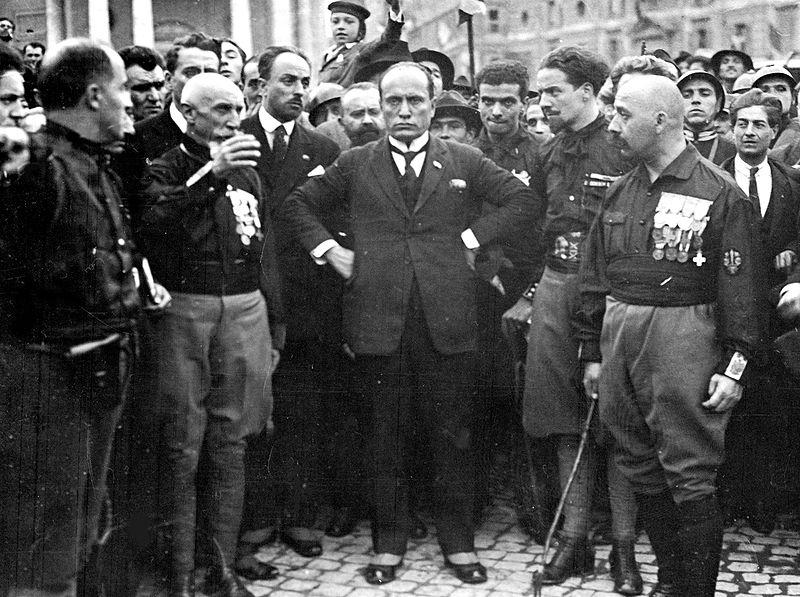
Mussolini immediately understood the importance of appearances. The 1920s was the early age of mass media, especially radio, and an intrinsic part of fascism was public spectacle. Mussolini staged enormous public exhibitions and rallies and he carefully controlled how he was portrayed in the media – the press was forbidden to mention his age or his birthday, to give the illusion that he never aged. He was always on the move, usually in a race car, and usually accompanied by models, actresses, and socialites years his junior. He spoke about his own “animal magnetism” and often walked around without a shirt on as a kind of (would be) herculean archetype.
Officially, Italian Fascism promised to end the class conflict that lay at the heart of socialist ideology by favoring what it called “corporatism” over mere capitalism. Corporatism was supposed to be a unified decision-making system in which workers and business owners would serve on joint committees to control work. In fact, the owners derived all of the benefits; trade unions were banned and the plight of workers degenerated without representation.
What Italian Fascism did do for the Italian people was essentially ideological and, in a sense, emotional: it directed youth movements and recreational clubs and sought the involvement of all Italians. It glorified the idea of the Italian people and in turn many actual Italians did come to feel great national pride, even if they were working in difficult conditions in a stagnant economy. In turn, Fascist propaganda tried to inculcate Italian pride and Fascist identity among Italian citizens, while Fascist-led police forces targeted would-be dissidents, sentencing thousands to prison terms or internal exile in closed prison villages (not unlike some of the Russian gulags that would exemplify a different but related totalitarian system to the east).
While Mussolini was often praised in the foreign press, including in American newspapers and magazines, for accomplishments like making (a few) Italian trains run on time, in the long term the Fascist government proved to be inefficient and often outright ineffectual. Mussolini himself, convinced of his own genius, made arbitrary and often foolish decisions, especially when it came to building up and training the Italian military. The circle of Fascist leaders around him were largely corrupt sycophants who lied to Mussolini about Italy’s strength and prosperity to keep him happy. When World War II began in 1939, the Italian forces were revealed to be poorly trained, equipped, and led.
The Weimar Republic
One place in Europe during the interwar period stands out as a microcosm of the political and cultural struggles occurring elsewhere: Weimar Germany. Named after the resort town in which its constitution was written in early 1919, the Weimar Republic represented a triumphant culmination of liberalism. Its constitution guaranteed universal suffrage for men and women, fundamental human rights, and the complete rejection of the remnants of monarchism. Unfortunately, the government of the new republic was deeply unpopular among many groups, including right-wing army veterans like a young Adolf Hitler.
One great lie that poisoned the political climate of the Weimar Republic was, as mentioned above, the “stab-in-the-back” myth. Toward the end of World War I, Germany was losing. Its own General Staff informed the Kaiser of this fact; with American troops and munitions flooding in, it was simply a matter of time before the Allies were able to march in force on Germany. As defeat loomed, however, the military leaders Hindenburg and Ludendorff, along with the Kaiser himself, concocted the idea that Germany could have kept fighting, and won, but instead public commitment to the war wavered because of agitators on the home front and saboteurs who crippled military supply lines. Usually, according to the conspiracy theory, those responsible were some combination of Jews and communists (and, of course, Jewish communists). This was an outright lie, but it was a convenient lie that the political right in Germany could cling to, blaming “Jewish saboteurs” and “Bolshevik agents” for Germany’s loss.
The Versailles Treaty had also required Germany to disarm; the German army went from millions of men to a mere 100,000 soldiers. It was forbidden from building heavy military equipment or having a fleet of more than a handful of warships. Given the social prestige and power associated with the German military before the war, this was an enormous blow to German pride. While the nations of Europe pledged to pursue peaceful resolutions to their problems in the future, many Germans were still left with a sense of vulnerability, particularly as the Bolsheviks cemented their control by the end of the 1920s in Russia.
Neither did the Weimar government itself inspire much confidence. Its parliament, the Reichstag, was trapped in an almost perpetual state of political deadlock. Its constitution stipulated that voting was proportional, with the popular vote translated into a corresponding number of seats for the various political parties. Unfortunately, given the vast range of political allegiances present in German society, there were fully 32 different parties, representing not just elements of the left–right political spectrum, but regional and religious identities as well. The most powerful parties were those of the far left, the communists, and the far right, initially monarchists and conservative Catholics, with the Nazis rising to prominence at the end of the 1920s. Thus, it was nearly impossible for the Reichstag to govern, with the various parties undermining one another’s goals and coalition governments crumbling as swiftly as they formed.

Simultaneously, the Weimar Republic faced ongoing economic issues, which fed into the resentment of most Germans toward the terms of the Versailles Treaty and its reparation payments (set to 132 billion gold marks annually, although that amount was renegotiated and lowered over the course of the decade). The actual economic impact of those payments is still debated by historians; what is not debated is that Germans regarded them as utterly unjust, since they felt that all of the countries of Europe were responsible for World War I, not just Germany. Especially in moments of economic crisis, many otherwise “ordinary” Germans looked to political extremists for possible solutions; to cite the most important example, the electoral fortunes of the Nazi party rose and fell in an inverse relationship to the health of the German economy. It was in this context of economic instability and political dysfunction that an extreme right-wing fringe group from the southern German state of Bavaria, the National Socialist German Workers Party, began to attract attention.
The Nazis
Any discussion of the Nazis must start with Adolf Hitler. It is impossible to overstate Hitler’s importance to Nazism: his own private obsessions became state policy and were used as the justification for war and genocide. His unquestionable powers of public speaking and political maneuvering transformed the Nazis from a small fringe group to a major political party, and while he was largely ineffective as a practical decision-maker, he remained central to the image of strength, vitality, and power that the Nazis associated with their state. Hitler was also one of the three “greatest” murderers of the twentieth century, along with Josef Stalin of the Soviet Union and Mao Tse-Tung of China. His obsession with a racialized, murderous vision of German power translated directly into both the Holocaust of the European Jews and World War II itself.
Nothing about Hitler’s biography would seem to suggest his rise to power, however. Hitler was born in Austria in 1889, a citizen of the Austro-Hungarian Empire. He dreamed of being an artist as a young man, but was rejected by the Academy of Fine Arts in the Austrian capital of Vienna – many of his works survive, depicting boring, uninspired, and moderately well-executed Austrian landscapes. Listless and lazy, but convinced from adolescence of his own greatness, Hitler invented the idea that the rejection was due not to his own lack of talent, but because of a shadowy conspiracy that sought to undermine his rise to prominence.
For several years before the outbreak of World War I, Hitler lived in Vienna in flophouses, cheap hotels for homeless men, and there he discovered right-wing politics and cultivated a growing hatred for Austria’s ethnic and linguistic diversity. Hitler spent his days drifting around Vienna, absorbing the rampant anti-Semitism of Austrian society and developing his own theories about Jews and other “foreign” influences. Likewise, he read popular works of racist pseudo-scholarship that glorified a fabricated version of German history. It was in Vienna that he discovered his own talent for public speaking, as well. The first groups he held enraptured by his improvised speeches about German greatness and the Jewish (and Slavic) peril were his fellow flophouse residents.
Hitler regarded the fact that Germany and Austria were separate countries as a terrible historical error. He hated the weak Austrian government and fled to Germany rather than serve his required military service in Austria. Much to his delight, World War I broke out when he was already in Germany; he enthusiastically volunteered for the German army and served at the western front, surviving both a poison gas attack and shrapnel from an exploding shell. Unlike most veterans of the war, Hitler experienced combat and service in the trenches as exhilarating and fulfilling, and he was completely without compassion—he would later shock his own generals during World War II by his callousness in spending German lives to achieve symbolic military objectives.
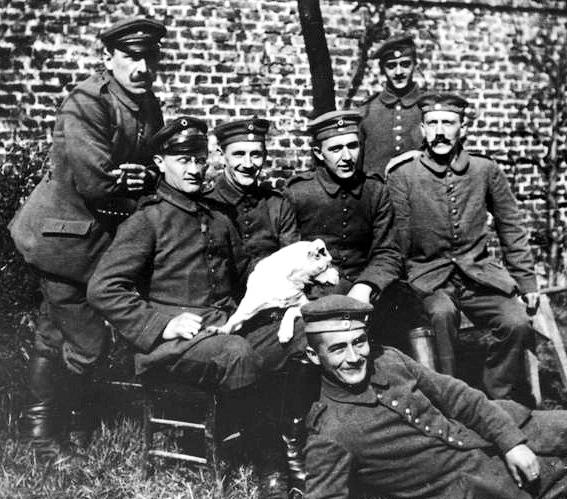
After the war, he was sent by the army to the southern German city of Munich, which was full of angry, disenchanted army veterans like himself. His assignment was to investigate a small right-wing group, the German Workers Party. His “investigation” immediately transformed into enthusiasm, finding like-minded conservatives who loathed the Weimar Republic and blamed socialism and something they called “international Jewry” for the defeat of Germany in the war. He swiftly rose in the ranks of the Nazis, becoming the Führer (“Leader”) of the party in 1921 thanks to his outstanding command of oratory and his ability to browbeat would-be political opponents. He unceremoniously ejected the party’s founder in the process. Under Hitler’s leadership, the party was renamed the National Socialist German Workers Party (“Nazi” is derived from the German word for “national”), and it adopted the swastika, long a favorite of racist pseudo-historians looking for the ancient roots of the fabricated “Aryan” race, as its symbol.
What made Nazi ideology distinct from that of their Italian Fascist counterparts was its emphasis on biology. The Nazis believed that races were biological entities, that there was something inherent in the blood of each “race” that had a direct impact on its ability to create or destroy something as vague as “true culture.” According to Nazi ideology, only the so-called Aryan race, Germans especially but also including related white northern Europeans like the Danes, the Norwegians, and the English, had ever created culture or been responsible for scientific progress. Other races, including some non-European groups like the Persians and the Japanese, were considered “culture-preserving” races who could at least enjoy the benefits of true civilization. At the bottom end of this invented hierarchy were “culture-destroying” races, most importantly Jews but also including Slavs, like Russians and Poles. In the great scheme for the Nazi new world order, Jews would be somehow pushed aside entirely and the Slavs would be enslaved as manual labor for “Aryans.”
Hitler himself invented this crude scheme of racial potential, codifying it in his autobiography Mein Kampf (see below). He was obsessed with the idea that the German race teetered on the brink of extinction, tricked into accepting un-German concepts like democracy or communism and foolishly interbreeding with lesser races. Behind all of this was, according to him, the Jews. Hitler claimed that the Jews were responsible for every disaster in German history; the loss of World War I was just the latest in a long string of catastrophes for which the Jews were responsible. The Jews had invented communism, capitalism, pacifism, liberalism, democracy…anything and everything that supposedly weakened Germany from Hitler’s perspective.
In 1921, under Hitler’s leadership, the Nazis organized a paramilitary wing called the Stormtroopers (SA in their German acronym). In 1923, inspired by the Italian Fascists’ success in seizing power in Italy, Hitler led his fellow Nazis in an attempt to seize the regional government of the German region of Bavaria, of which Munich is the capital. This would-be revolution is remembered as the Beer-Hall Putsch. It failed, but Hitler used his ensuing trial as a national stage, as the proceedings were widely reported on by the German press. The court officials, who sympathized with his politics, gave him and his followers ludicrously short sentences in minimum security prisons, a sentence Hitler spent dictating his autobiography, Mein Kampf (“My Struggle”), to the Nazi party’s secretary, Rudolf Hess.
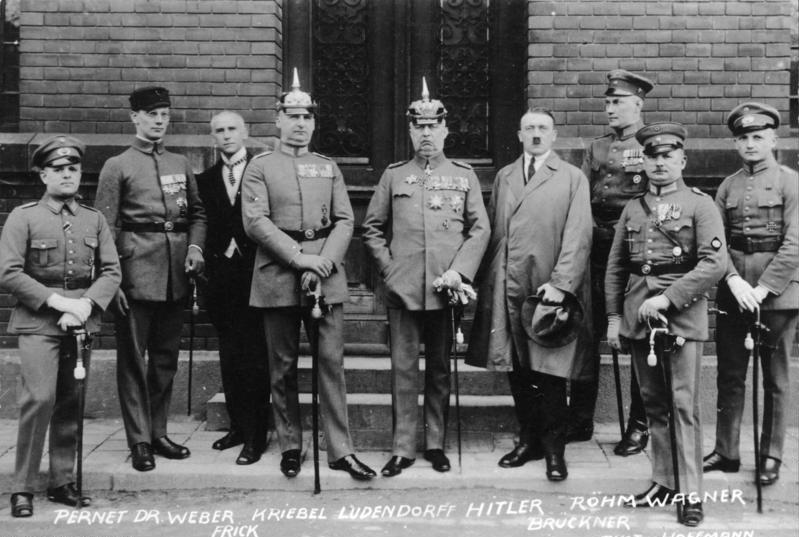
When he was released in nine months (including time served and recognition of his good behavior), Hitler was a minor national celebrity on the right. The Nazis were still a fringe group, but they were now a fringe group that people had heard of. Nazi Stormtroopers harassed leftist groups and engaged in brawls with communist militants. The party created youth organizations, workers’ and farmers’ wings, and women’s groups. They held rallies constantly, creating early versions of “interest groups” to gauge the issues that attracted the largest popular audience. Even so, they did not have mass support in the 1920s—they only won 2.6% of the national vote in 1928.
The Great Depression, however, threw the Weimar government and German society into such turmoil that extremists like the Nazis suddenly gained considerable mass appeal. Promising the complete repudiation of the Versailles Treaty, the build-up of the German military, an end to economic problems, and a restoration of German pride and power, the Nazis steadily grew in popularity: an electoral breakthrough in 1930 saw them win 18% of the seats in the Reichstag. In 1932 they won 37% of the national vote, the most they ever won in a free, legal election.
That being noted, the Nazis never came close to winning an actual majority in the Reichstag. They were essentially a strong, combative far-right minority party. Thanks to the advent of the Depression, more “ordinary Germans” than before were attracted to their message, but that message did not seem at the time to be greatly different than the messages of other right-wing parties. That said, the Nazis were masters of fine-tuning their messages for the electorate; most of their propaganda had to do with German pride, unity, and the need for social and economic order and prosperity, not the hatred of Jews or the need to launch attacks on other European nations. They offered themselves as a solution to the inefficiency of the Weimar Republic, not as a potential bloodbath.
In fact, 1932 represented both the high point and what could have been the beginning of the decline of the Nazis as a party. The presidential election that year saw Hitler lose to Hindenburg, who had served as president since 1925, despite his own contempt for democracy. The Nazis lost millions of votes in the subsequent Reichstag election, and Hitler even briefly considered suicide. Unfortunately, in January of 1933, Hindenburg was convinced by members of his cabinet led by a conservative Catholic politician, Franz von Papen, to use Hitler and the Nazis as tools to help dismantle the Weimar state and replace it with a more authoritarian political order. Thus, Hindenburg appointed Hitler chancellor, the second-most powerful political position in the state.
Hitler seized the opportunity to launch a full-scale takeover of the German government. The Reichstag building was set on fire by an unknown arsonist in February, and Hitler blamed the communists, pushing through an emergency measure (the Reichstag Fire Decree) that suspended civil rights. That allowed the state to destroy the German Communist Party, imprisoning 20,000 of its members in newly built concentration camps. Through voter fraud and massive intimidation by the Nazi Stormtroopers, new elections saw the Nazis win 49% in the next election. Soon, with the aid of other conservative parties, the Nazis pushed through the Enabling Act, which empowered Hitler and the presidential cabinet to pass laws by decree. In July, the Nazis outlawed all parties except themselves. By the summer of 1933, the Nazis controlled the state itself, with Hindenburg (impressed by Hitler’s decisiveness) willingly signing off on their measures.
The Nazi government that followed was a mess of overlapping bureaucracies with no clear areas of control, just influence. The Weimar constitution was never officially repudiated, but the letter of laws became far less important than their interpretation according to the “spirit” of Nazism. In lieu of a rational political order, there was a kind of governing principle that one Nazi party member described as “working towards the Führer”: trying to determine the “spirit” of Nazism and abiding by it rather than following specific rules or laws. The only unshakable core principle was the personal supremacy of the Führer, who was supposed to embody Nazism itself.
Nazism was not just a governing philosophy, however. Hitler was obsessed with winning over “ordinary Germans” to the party’s outlook, and to that end the state both bombarded the population with propaganda and sought to alleviate the dismal economic situation of the early 1930s. The Nazi state poured money into a debt-based recovery from the Depression (the economics of the recovery were totally unsustainable, but the Nazi leadership gambled that war would come before the inevitable economic collapse). Employment recovered somewhat as the state funded huge public works and, after he publicly broke with the terms of the Versailles Treaty in 1935, rearmament. Even though there were still food and consumable shortages, many Germans felt that things were better than they had been. The Nazis refused to continue war reparations and soon the rapidly rebuilding military was staging enormous public rallies.
Ultimately, the Nazi party controlled Germany from 1933 until Germany surrendered to the Allies in World War II in 1945. That period is remembered as that of the Third Reich, the Nazis’ own term for what Hitler promised would be a “1,000 years” of German dominance. During that time, the Nazis sponsored a full-scale attempt to recreate German culture and society to correspond with their vision of a racialized, warlike, and “purified” German nation. They claimed to have launched a “national revolution” in the name of unifying all Germans in one Volksgemeinschaft: people’s community.
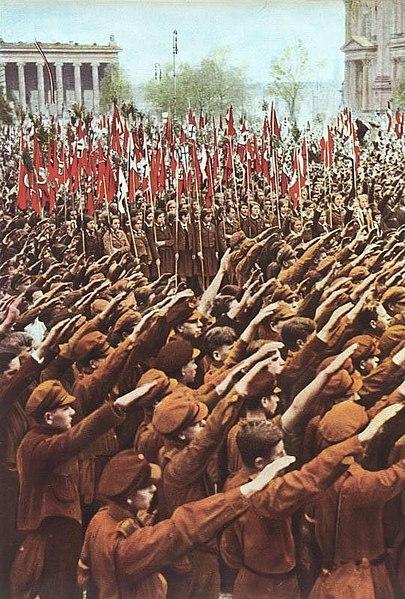
The Nazis targeted almost every conceivable social group with a specific propaganda campaign and encouraged (or required) German citizens to join a specific Nazi league: workers were encouraged to work hard for the good of the state, women were encouraged to produce as many healthy children as possible (and to stay out of the workplace), boys were enrolled in a paramilitary scouting organization, the Hitler Youth, and girls in the League of German Girls, trained as future mothers and domestics. All vocations and genders were united in the glorification of the military and, of course, of the Führer himself (“Heil Hitler” was the official greeting used by millions of German citizens, whether or not they ever joined the Nazi party itself). The purpose of the campaigns was to win the loyalty of the population to the regime and to Hitler personally, and nearly the entire population at least paid lip service to the new norms.
The dark side of both the propaganda and the legal framework of the Third Reich was the suspension of civil rights and the concomitant campaigns against the so-called “enemies” of the German people. The Nazis vilified Jews, as well as other groups like people with disabilities and the Romani (better known as “Gypsies,” although the term itself is something of an ethnic slur). Starting in 1933, the state began a campaign of involuntary sterilizations of disabled and mixed-race peoples. Jewish businesses were targeted for vandalism and Jewish people were attacked. In 1935 the Nazis passed the so-called “Nuremberg Laws” which outlawed Jews from working in various professions, stripped Jews of citizenship, and made sex between Jews and non-Jews a serious crime.
Even as Germans were encouraged to identify with the Nazi state, and joining the Nazi Party itself soon became an excellent way to advance one’s career, the Nazis also held out the threat of imprisonment or death for those who dared defy them. The first concentration camp was opened within weeks of Hitler’s appointment of chancellor in 1933, and a vast web of police forces soon monitored the German population. The most important organization in Nazi Germany was the SS (Schutzstaffel, meaning “protection squadron”), an enormous force of dedicated Nazis with almost unlimited police powers. The SS had the right to hold anyone indefinitely, without trial, in “protective custody” in a concentration camp, and the Nazi secret police, the Gestapo, were merely one part of the SS. This combination of incentives (e.g. propaganda, programs, incentives) and threats (e.g. the SS, concentration camps) helps explain why there was no significant resistance to the Nazi regime from within Germany.
The Spanish Civil War
The first real war launched by fascist forces was not in Italy or Germany, however, but in Spain. The greatest of the European powers in the sixteenth century, Spain had long since sunk into obscurity, commercial weakness, and backwardness. Its society in 1920 was very much like it had been a century earlier: most of the country was populated by poor rural farmers and laborers, and an alliance of the army, Catholic church, and old noble families still controlled the government in Madrid. The king, Alfonso XIII, still held real power, despite his own personal ineptitude. In many ways, Spain was the last place in Europe that clung to the old order of the nineteenth century.
Socialists and liberals were increasingly militant by the early 1920s, and Catalan and Basque nationalists likewise agitated for independence from Spain. From 1923 to 1930, a general named Primo de Rivera acted as a virtual dictator (with the support of the king) trying to drag Spain into the twentieth century by building dams, roads, and sewers. He weakened what representation there was in the state by making government ministers independent of the parliament (the Cortes) and he even managed to lose support in the army by interfering in the promotion of officers.
In 1931, the king abdicated after an anti-monarchist majority took the Cortes. The result was a republic, whose parliament was dominated by liberals and moderate socialists. The parliament pushed through laws that formally separated church and state (for the first time in Spanish history) and redistributed land to the poor, seized from the enormous estates of the richest nobles. Peasants in the countryside went further, attacking churches, convents, and the estates of the nobility. Meanwhile, Spanish communists sought a Russian-style communist revolution and, even further to the left, a substantial anarchist coalition aimed at the complete abolition of government. Thus, the left-center coalition was increasingly beleaguered, as the far left gravitated away and the nobility and clergy joined with the army in an anti-parliamentarian right. Two years of anarchy resulted, from 1933–1935.
In 1935, as the forces of the right rallied around a general named Francisco Franco, the socialists, liberals, anarchists, and communists formed a Popular Front to fight it. More chaos ensued, with Franco’s forces growing in power and the Popular Front suffering from infighting (i.e. the anarchists, communists, liberals, and nationalist minorities did not work well together). Franco’s traditional conservative forces joined with Spanish fascists, the Falange, soon openly supported by Nazi Germany and Fascist Italy. In 1936, Franco’s forces seized several key regions in Spain.
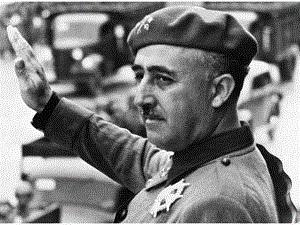
The war began in earnest in that year. It was hugely bloody; probably about 600,000 people died, of which 200,000 were “loyalists” (the blanket term for the pro-republican, or at least anti-monarchical, forces) summarily executed after being captured by the “nationalists” under Franco. Meanwhile, the loyalists carried out atrocities of their own, targeting especially members of the church. One of the iconic moments in the war was the arrival of over 20,000 foreign volunteers on the side of the loyalists, including the Abraham Lincoln Brigade from the United States. Both the American writer Ernest Hemingway and the English writer George Orwell fought in defense of the republic.
While, officially, there was an international non-interventionist agreement among the governments of Europe and the US with regards to Spain, Germany and Italy blatantly violated it and provided both troops and equipment to the nationalist forces. The most effective support provided by Italy or Germany came from the German air force, the Luftwaffe, which used Spain as a training ground with real targets. The loyalists had no means to fight against planes, so they suffered consistent defeats and setbacks from German bombing raids. Overall, the Spanish Civil War allowed Italy and Germany to “try out” their new armies before committing to a larger war in Europe (Italy, however, did launch a brutal invasion of Ethiopia in 1934 as well).
The nationalists triumphed in early 1939, having cut off the pockets of loyalists off from one another. They were recognized as the legitimate government of Spain internationally, and despite their promises to the contrary, they immediately began carrying out reprisals against the now-defeated loyalists. Franco adopted the title of Caudillo, or leader, in the same manner as Mussolini and Hitler. Where Spain differed from the other fascist powers was that Franco was well aware of its relative weakness and deliberately avoided an expansionist foreign policy; Hitler once spent a fruitless day trying to convince him to join the war once World War II was underway.
Franco’s regime, which united the old nobles, the army, and the Catholic church, controlled the country until Franco’s death in 1975. Just as Spain was one of the last countries still tied to the old political order of kings and nobles after World War I, it was among the last fascistic countries long after Hitler’s Germany and Mussolini’s Italy had fallen.
Image Citations (Wikimedia Commons):
Nikolai II and George V – Public Domain
Rasputin – Public Domain
Lenin Speech – Public Domain
Klimt The Kiss – Public Domain
Klimt Philosophy – Public Domain
Alice Joyce – Public Domain
March on Rome – Public Domain
Weimar Electoral Results – Pass3456
Hitler in WWI – Creative Commons License
Beer Hall Putsch – Creative Commons License
Hitler Youth and League of German Girls – Creative Commons License
Franco – Creative Commons License

